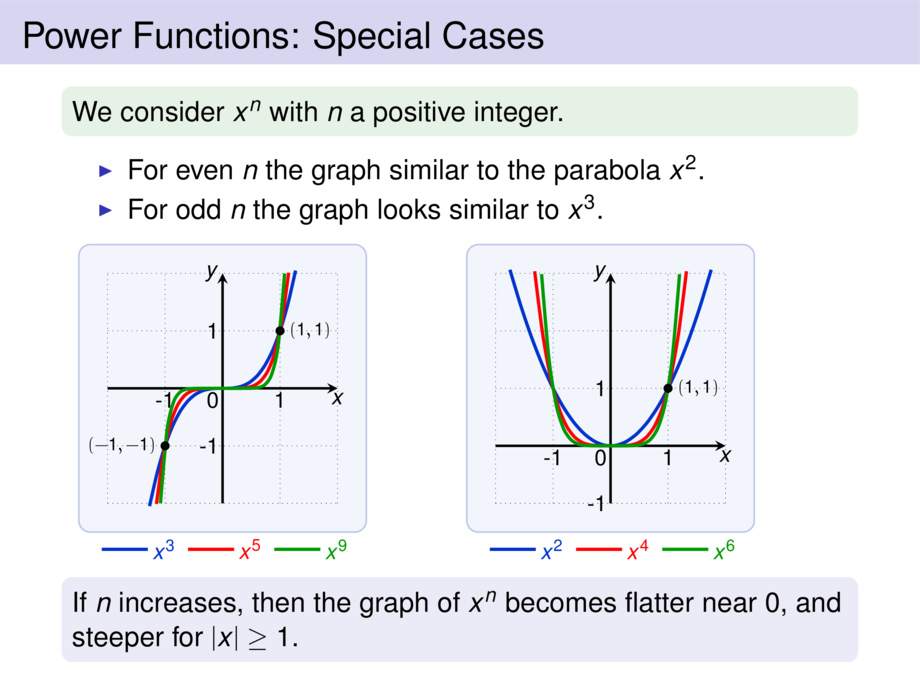



































































































37/353
\begin{frame}
\frametitle{Power Functions: Special Cases}
\begin{exampleblock}{}
We consider $x^n$ with $n$ a positive integer.
\end{exampleblock}
\pause
\begin{itemize}
\item For even $n$ the graph similar to the parabola $x^2$.
\item For odd $n$ the graph looks similar to $x^3$.
\end{itemize}
\medskip
\begin{minipage}{.49\textwidth}
\scalebox{.8}{
\begin{tikzpicture}[default,baseline=0ex]
\diagram{-2}{2}{-2}{2}{1}
\diagramannotatez
\diagramannotatex{-1,1}
\diagramannotatey{-1,1}
\begin{scope}[ultra thick]
\draw[cblue] plot[smooth,domain=-1.27:1.27,samples=20] (\x,{pow(\x,3)});
\draw[cred] plot[smooth,domain=-1.15:1.15,samples=20] (\x,{pow(\x,5)});
\draw[cgreen] plot[smooth,domain=-1.08:1.08,samples=20] (\x,{pow(\x,9)});
\draw[cblue] (-2.1cm,-2.8cm) -- node [at end,right] {$x^3$} +(.8cm,0);
\draw[cred] (-.6cm,-2.8cm) -- node [at end,right] {$x^5$} +(.8cm,0);
\draw[cgreen] (.9cm,-2.8cm) -- node [at end,right] {$x^9$} +(.8cm,0);
\node (a) [include=black,minimum size=1mm] at (1,1) {};
\node[r=(a)] {$(1,1)$};
\node (b) [include=black,minimum size=1mm] at (-1,-1) {};
\node[l=(b)] {$(-1,-1)$};
\end{scope}
\end{tikzpicture}
}
\end{minipage}
\begin{minipage}{.49\textwidth}
\scalebox{.8}{
\begin{tikzpicture}[default,baseline=1cm]
\diagram{-2}{2}{-1}{3}{1}
\diagramannotatez
\diagramannotatex{-1,1}
\diagramannotatey{-1,1}
\begin{scope}[ultra thick]
\draw[cblue] plot[smooth,domain=-1.75:1.75,samples=20] (\x,{pow(\x,2)});
\draw[cred] plot[smooth,domain=-1.32:1.32,samples=20] (\x,{pow(\x,4)});
\draw[cgreen] plot[smooth,domain=-1.2:1.2,samples=20] (\x,{pow(\x,6)});
\draw[cblue] (-2.1cm,-1.8cm) -- node [at end,right] {$x^2$} +(.8cm,0);
\draw[cred] (-.6cm,-1.8cm) -- node [at end,right] {$x^4$} +(.8cm,0);
\draw[cgreen] (.9cm,-1.8cm) -- node [at end,right] {$x^6$} +(.8cm,0);
\node (a) [include=black,minimum size=1mm] at (1,1) {};
\node[r=(a)] {$(1,1)$};
\end{scope}
\end{tikzpicture}
}
\end{minipage}
\pause
\begin{block}{}
If $n$ increases, then the graph of $x^n$ becomes
flatter near $0$, and steeper for $|x| \ge 1$.
\end{block}
\vspace{10cm}
\end{frame}

